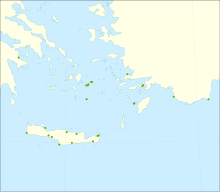Phoenix theophrasti
| Phoenix theophrasti | |
|---|---|

| |
| Cretan date palm at the beach in Vai, Crete | |
| Scientific classification | |
| Kingdom: | Plantae |
| Clade: | Tracheophytes |
| Clade: | Angiosperms |
| Clade: | Monocots |
| Clade: | Commelinids |
| Order: | Arecales |
| Family: | Arecaceae |
| Genus: | Phoenix |
| Species: | P. theophrasti
|
| Binomial name | |
| Phoenix theophrasti Greuter | |

| |
| Distribution map | |
Phoenix theophrasti, the Cretan date palm, is a
Taxonomy
The specific epithet theophrasti was chosen by the Swiss botanist Werner Greuter in 1967 for the fact that Theophrastus, the ancient Greek "father of botany", had described several types of palms, including one from Crete.[3][4]
A genomic study from New York University Abu Dhabi Center for Genomics and Systems Biology showed that domesticated date palm (Phoenix dactylifera) varieties from North Africa, including well-known varieties such as Medjool and Deglet Noor, are a hybrid between Middle East date palms and P. theophrasti.[5]
Description
Apart from the usually inedible dates and upright fruit clusters, the Cretan species can appear quite similar to the cultivated date.[4]
Phoenix theophrasti grows up to 15 m tall, usually with several slender stems. The
Distribution
The species has a relatively restricted distribution, mostly confined to southern Greece (a few sites on Crete and nearby islands), as well as some places on the Turkish coast.
Greece
Sites on Crete include
Turkey
Its presence in Turkey was not described scientifically until the 1980s.[3] There are four stands in southwest Turkey,[7] especially on the Datça and Bodrum Peninsulas in Muğla Province and in Kumluca-Karaöz in Finike Bay. The plants form a grove in the village of Gölköy in northern Bodrum are considered by some as a subspecies, having a shorter stem (4–8 m) but longer fruit stalks (.6–2 m).[4]
References and external links
- .
- ISBN 9782831703527.
- ^ .
- ^ Principes. 39 (3): 117–122.
- PMID 30642962.
- ^ Vernicos, Nicolas. "Chalki in the Dodecanese".
{{cite journal}}: Cite journal requires|journal=(help) - ^ "Phoenix theophrasti". ARKive. Archived from the original on 30 June 2006. Retrieved 18 May 2006.
- Davis, P. H., ed. (1965-1985). Flora of Turkey. Edinburgh.
- Phoenix theophrasti – information, genetic conservation units and related resources. European Forest Genetic Resources Programme (EUFORGEN)

